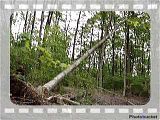redprospector
Addicted to ArboristSite
I can't tell you how I'd handle these trees without being able to see them. Even then, sometimes you second guess yourself.
We had one like your #3 after a wind storm in December. It was in town, and there was a structure it would hit if we just pulled it down. So we set a snatch block low in another tree and ran the mainline from my skidder through it and up the tree, there were two other cables used to stablize it too. Then it came down a piece at a time.
Here's some pic's.

First "log" coming down, after the top.

You can see the house on the right.

The more was cut, the more it stood up. Until it was gone.

Andy
We had one like your #3 after a wind storm in December. It was in town, and there was a structure it would hit if we just pulled it down. So we set a snatch block low in another tree and ran the mainline from my skidder through it and up the tree, there were two other cables used to stablize it too. Then it came down a piece at a time.
Here's some pic's.

First "log" coming down, after the top.

You can see the house on the right.

The more was cut, the more it stood up. Until it was gone.

Andy






































